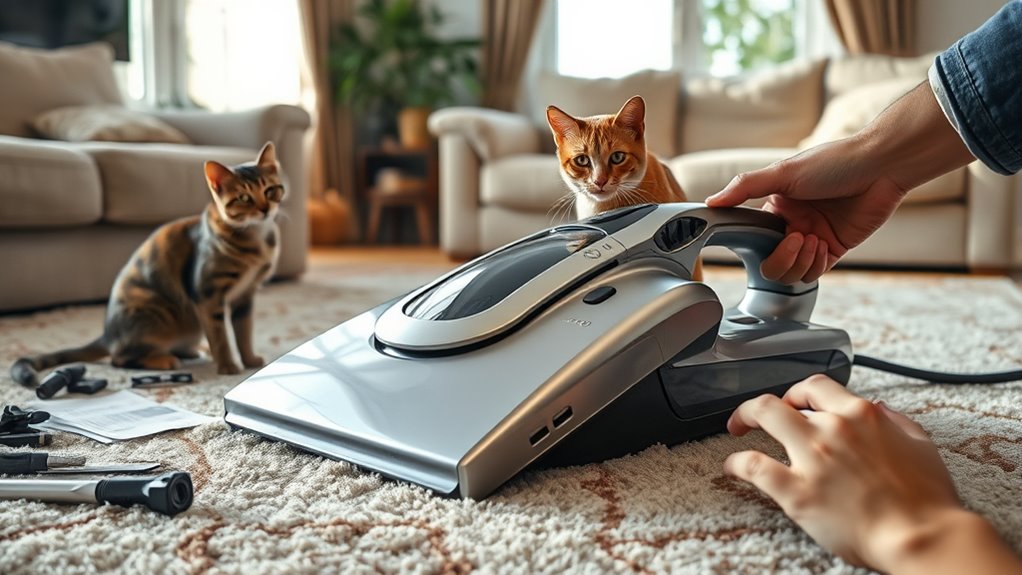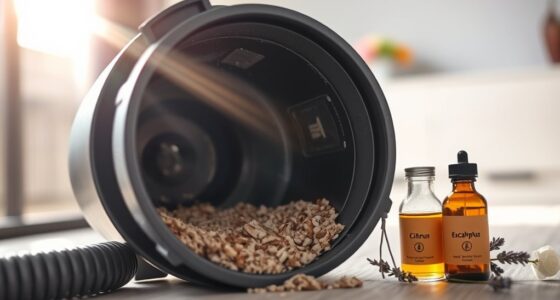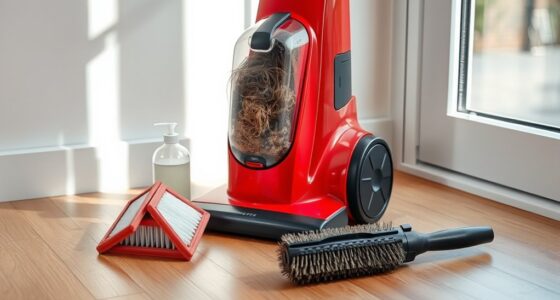If your vacuum’s making strange noises, it’s likely due to clogged filters, blocked tubes, or worn bearings. Start by checking the filters and hoses for blockages, and clean or replace them as needed. Listen for specific sounds: grinding might indicate debris, while buzzing could signal motor issues. Regular maintenance is key to preventing noise. If you’re still hearing unusual sounds after these steps, there’s more to uncover about keeping your vacuum in top shape.
Key Takeaways
- Check for clogged filters and clean them regularly to maintain airflow and reduce noise levels.
- Inspect hoses and tubes for blockages that may strain the motor and cause unusual sounds.
- Examine the brush roll for trapped debris, which can create grinding or rattling noises during operation.
- Ensure the fan near the motor is securely attached and free from faults that may result in abnormal sounds.
- Look for worn parts, such as bearings or brushes, which can increase friction and contribute to loud noises.
Common Causes of Loud Noises in Vacuums
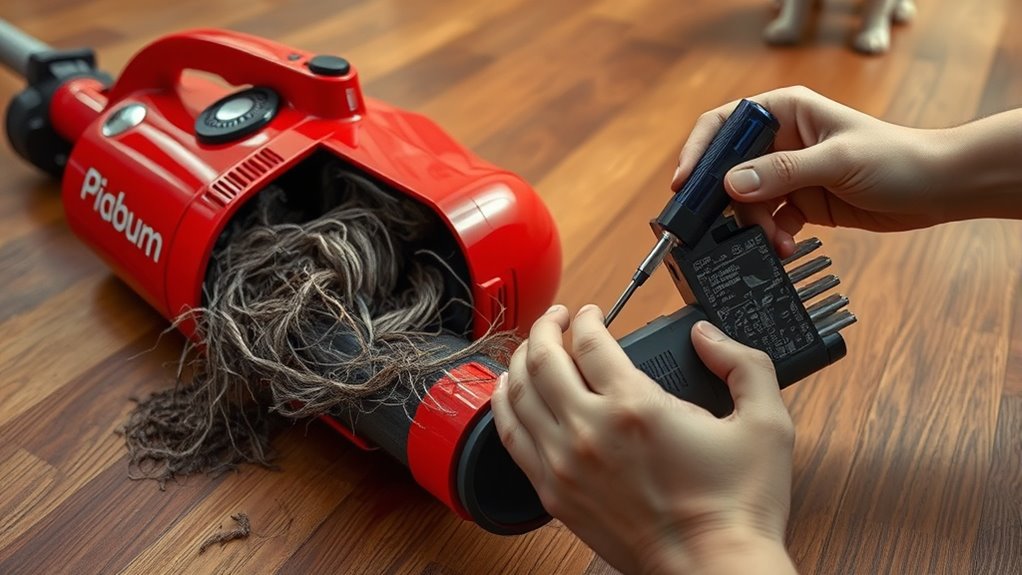
When your vacuum starts making loud noises, it’s often a sign that something’s wrong. One of the common reasons is clogged filters, which restrict airflow and force your vacuum to work harder, causing increased noise levels.
Blocked tubes can also choke airflow, putting a strain on the motor and leading to louder sounds. A faulty fan near the motor may become loosened or damaged, resulting in abnormal noises due to improper airflow.
Blocked tubes can restrict airflow, straining the motor and causing increased noise, while a damaged fan can lead to further abnormal sounds.
Additionally, worn-out brush bearings in the brush roller can create friction, producing noise during operation.
Finally, motor issues, like damage or wear, can manifest as unusual sounds, sometimes accompanied by burning smells.
Regular maintenance can help prevent these problems and keep your vacuum running quietly.
Identifying Specific Noise Types
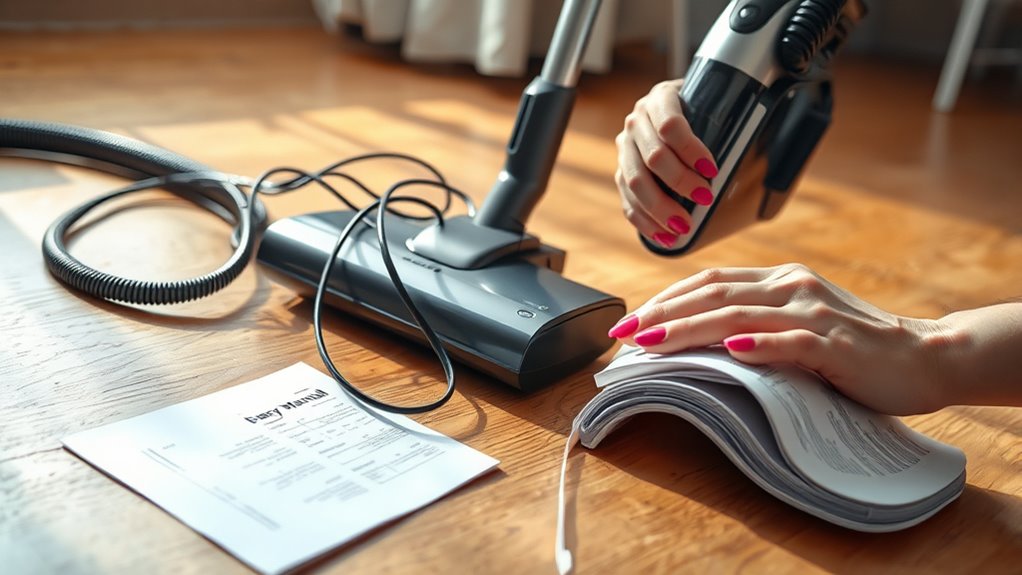
Identifying specific noise types in your vacuum can help you pinpoint the underlying issue and take corrective action.
If you hear grinding noises, it often means debris is trapped in the brush rolls or wheels, which can cause wear and tear.
Clicking sounds might indicate improperly replaced brushes or misalignment during docking, so check for adjustments.
Squeaking noises typically arise from debris lodged in moving parts, requiring a thorough cleaning.
Rattling sounds can signal jammed debris in the main brush or vacuum bag, which you should clear to prevent further damage.
Finally, buzzing noises may come from debris on the charging contacts or within the motor area, suggesting a need for inspection and cleaning to maintain peak performance.
Maintenance Steps to Reduce Noise
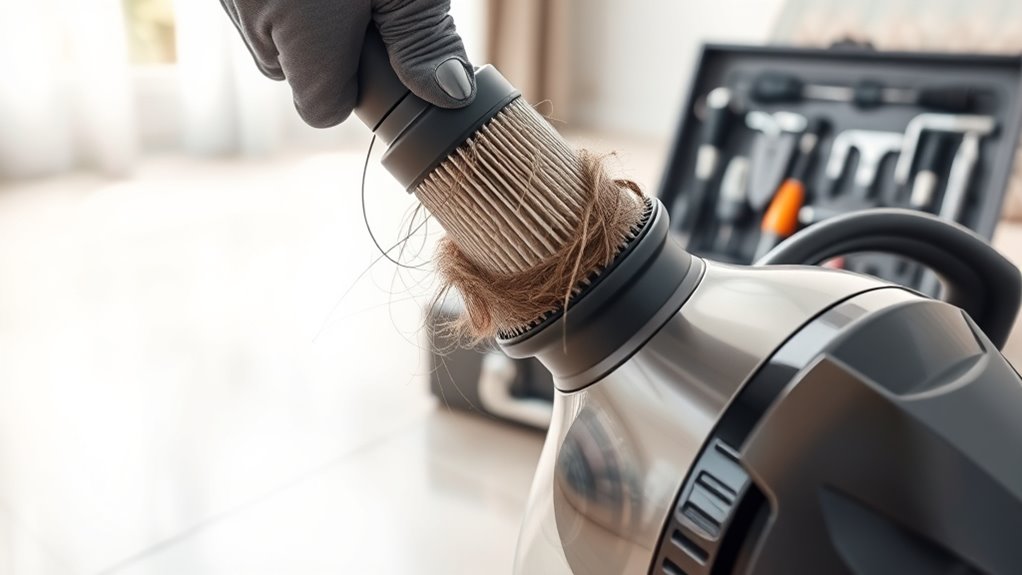
To keep your vacuum running quietly, start by regularly cleaning the filters to prevent airflow blockages.
Next, inspect and clear the hoses to maintain peak performance.
Finally, don’t forget to check the brush roll for debris that could increase noise levels during use.
Regular Filter Cleaning
Regular filter cleaning is crucial for maintaining a quiet vacuum, as accumulated grime can block airflow and lead to increased noise levels.
To keep your vacuum running smoothly, clean both the regular and HEPA filters every 1-3 months, depending on how often you use it. Gently rub the filters with lukewarm water and let them dry completely before putting them back in.
A clogged filter forces the motor to work harder, which not only increases noise but can also damage the vacuum over time.
Always check your vacuum’s user manual for specific instructions and maintenance schedules related to regular filter cleaning to guarantee peak performance and keep the noise at bay.
Inspect and Clear Hoses
Inspecting and clearing your vacuum hoses is essential for reducing noise and ensuring peak performance. Regular maintenance can prevent clogs and leaks that lead to unwanted sounds.
Follow these steps to keep your hoses in top shape:
- Detach hoses from both ends for thorough access.
- Inspect for blockages caused by large debris that obstructs airflow.
- Clean with a damp cloth to eliminate dust and grime buildup.
While you’re at it, check for any visible damage, like cracks or holes, which can cause air leaks and increase noise levels.
After clearing and cleaning, securely reattach the hoses to prevent rattling. Keeping your hoses clean and intact will greatly enhance your vacuum’s efficiency and quietness.
Brush Roll Maintenance
Maintaining the brush roll is essential for reducing noise and ensuring your vacuum operates smoothly.
Regularly inspect the brush roll for hair and debris buildup, as clogs can increase noise during operation. Remove the brush roll and clean it thoroughly to prevent rusting of bearings, which can lead to higher friction and unwanted sounds.
Make sure the brush roll is properly positioned and secured to avoid rattling caused by misalignment. Periodically lubricate the brush bearings to reduce friction and maintain a quieter performance.
Finally, replace any worn or damaged brush rolls promptly; new brushes can restore quiet operation and improve your vacuum’s overall cleaning efficiency.
Keeping your brush roll in top shape makes a significant difference!
Troubleshooting Noisy Vacuums
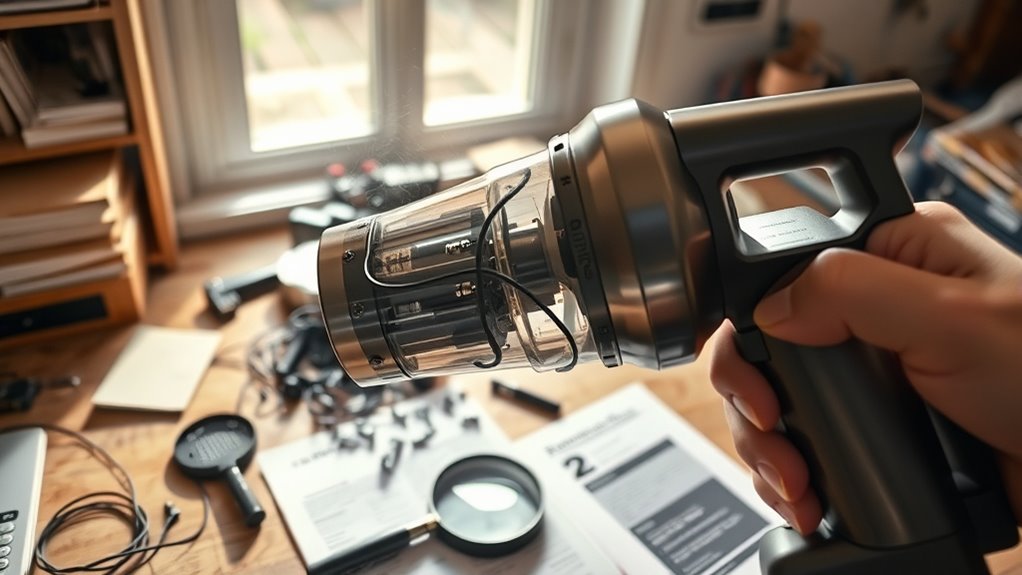
If your vacuum’s making strange noises, it’s time to troubleshoot the issue.
Common noise sources can often be traced back to clogged filters, blockages, or worn parts.
Let’s explore some maintenance tips and how to identify specific issues to get your vacuum running quietly again.
Common Noise Sources
When your vacuum starts making unexpected noises, it often signals underlying issues that need attention. Ignoring these loud sounds can lead to bigger problems down the line.
Here are some common noise sources to check:
- Clogged filters restricting airflow, causing the vacuum to work harder
- Blocked tubes that can create excessive noise when air is limited
- Worn-out brush bearings increasing friction, leading to louder operation
Additionally, a faulty fan near the motor or electrical motor issues may also contribute to abnormal sounds.
Investigating these areas can help you identify the source of the noise and determine the necessary repairs. Don’t let those loud noises go unchecked—address them promptly to keep your vacuum running smoothly.
Maintenance and Cleaning Tips
To keep your vacuum running quietly and efficiently, regular maintenance and cleaning are essential. Neglecting these tasks can lead to excessive noise levels and worn-out parts. Clean both the inner and outer filters frequently to prevent debris buildup. Inspect the vacuum hose for blockages and use a broomstick to clear any clogs. Don’t forget to remove hair and debris from the brush roll, as this can cause grinding sounds. Verify all components, like brushes and belts, are tight and aligned.
| Task | Frequency | Benefits |
|---|---|---|
| Clean filters | Monthly | Reduces excessive noise |
| Inspect vacuum hose | Every use | Prevents airflow blockages |
| Clean brush roll | Bi-monthly | Maintains peak performance |
| Check components | Monthly | Minimizes vibrations |
Identifying Specific Issues
While vacuuming, you might notice unusual sounds that signal underlying issues with your machine. Identifying these specific noises can help you troubleshoot effectively:
- Grinding noises: Often mean debris is lodged in the brush rolls or wheels—clean them thoroughly.
- Clicking sounds: May suggest misaligned or improperly replaced brushes—inspect and adjust to ascertain they’re seated correctly.
- Squeaking noises: Typically come from foreign objects caught in moving parts—carefully inspect and remove any debris.
Ignoring these loud or unusual sounds can lead to more significant problems.
Regular maintenance is key to keeping your vacuum running smoothly, so don’t hesitate to address these issues as they arise.
Fixing Common Noise Issues
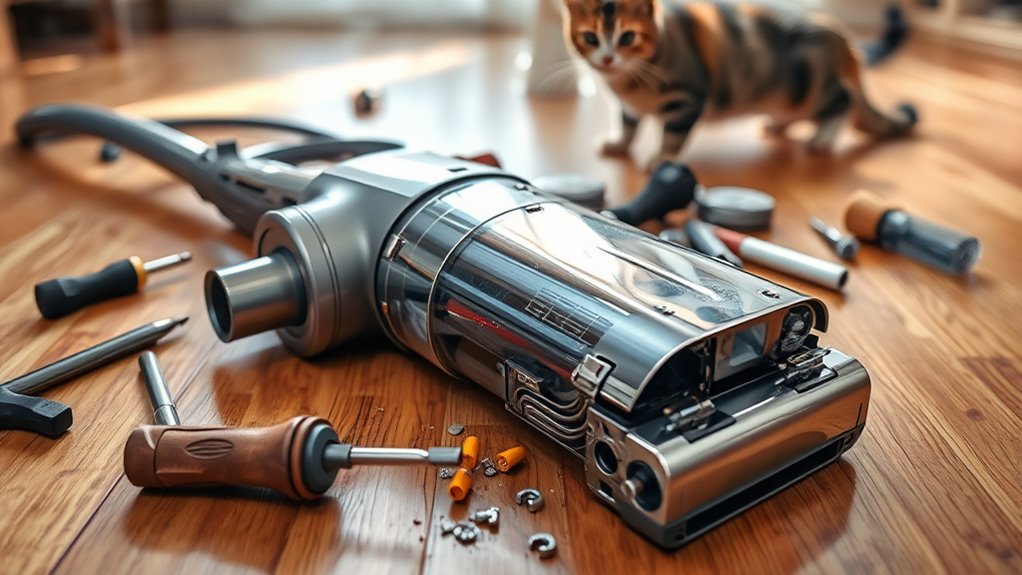
If you’ve noticed your vacuum making unusual noises, addressing common issues can help restore its quiet operation.
First, regularly clean your vacuum’s filters; clogged filters block airflow, straining the motor and contributing to noise.
Regularly cleaning your vacuum’s filters is essential to maintain airflow and minimize noise from the motor.
Next, inspect the vacuum tube for any blockages—use a metal wire to clear obstructions that might be choking airflow.
Check the fan near the motor; a faulty or loose fan can create abnormal sounds, so verify it’s properly attached.
Also, examine the brush bearings for rust or wear; worn bearings can increase friction and noise, possibly requiring a brush replacement.
Finally, make certain all components, including brushes and wheels, are properly installed and free from debris to avoid grinding or rattling noises. Additionally, regular maintenance improves vacuum performance and can significantly reduce noise issues.
Preventative Measures for Quiet Operation
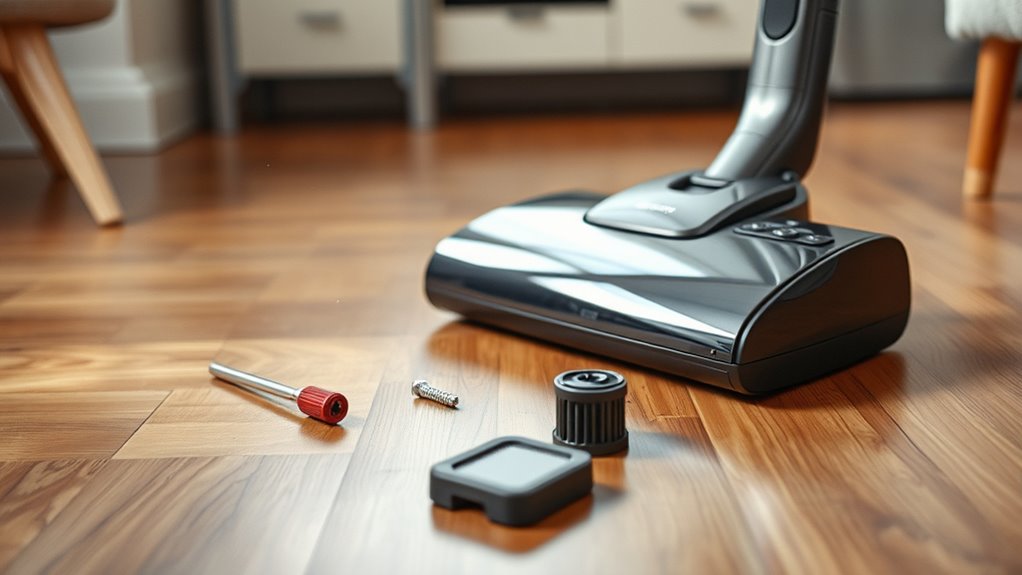
Maintaining a quiet vacuum is easier than you might think, especially when you incorporate regular preventative measures.
Here are some key steps to help you keep your vacuum cleaners operating quietly:
- Regularly clean and maintain filters, including HEPA filters.
- Schedule periodic inspections of the vacuum tube and hose.
- Check and replace worn-out brush bearings.
Additionally, always unplug your vacuum before performing maintenance tasks. Investing in a model with advanced sensors can also help minimize noise during operation. Many top rated vacuums are designed with sound-reducing features that enhance user experience. To further improve your vacuum’s performance, consider choosing one with advanced filtration systems that can contribute to quieter operation.
By following the manufacturer’s maintenance schedule, you can prevent excessive wear on parts that contribute to noise.
Keeping your vacuum clean by emptying the dustbin frequently and ensuring all components are free of debris is essential. Regular maintenance of anti-allergen technology can also help reduce noise levels.
If you have questions, don’t hesitate to reach out to customer service for assistance.
Embrace these preventative measures for quiet operation, and enjoy a peaceful cleaning experience.
When to Seek Professional Help
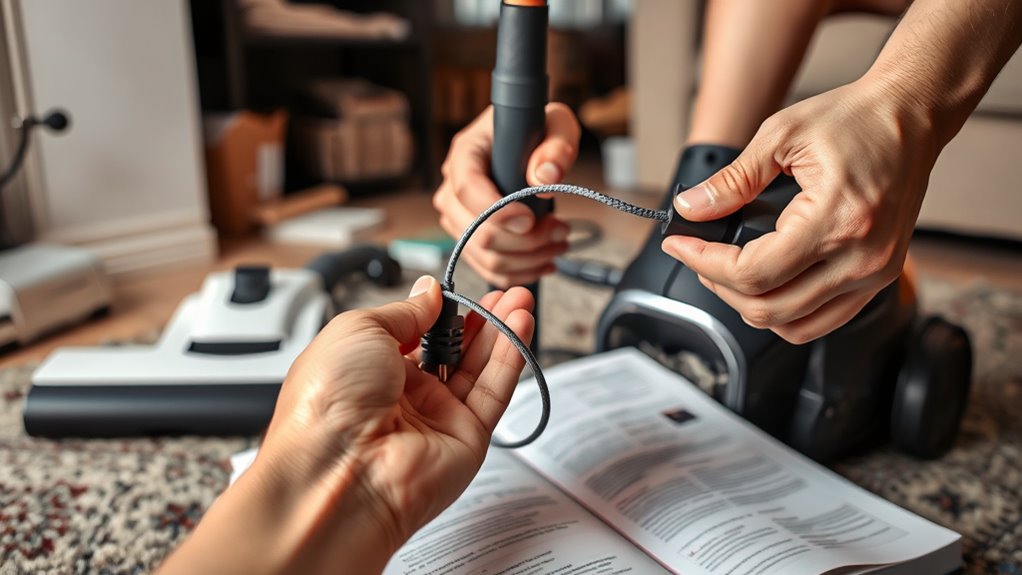
When should you consider calling in a professional for your vacuum troubles? If your vacuum’s producing loud, unusual noises that don’t go away after regular maintenance, it’s time to seek help. Also, watch for signs of motor damage like burning smells or smoke, which require immediate attention. If the fan’s loose or malfunctioning and you can’t fix it easily, consult a technician. Persistent noise, despite cleaning, often signals deeper mechanical issues. Finally, if your vacuum’s out of warranty and showing excessive wear, professional assistance is advisable. Here’s a quick guide:
| Situation | Action Required | Customer Support Needed |
|---|---|---|
| Loud, unusual noise | Seek professional help | Yes |
| Signs of motor damage | Immediate inspection | Yes |
| Loose or malfunctioning fan | Consult technician | Yes |
| Persistent noise | Expert assessment | Yes |
Customer Experiences and Support Resources
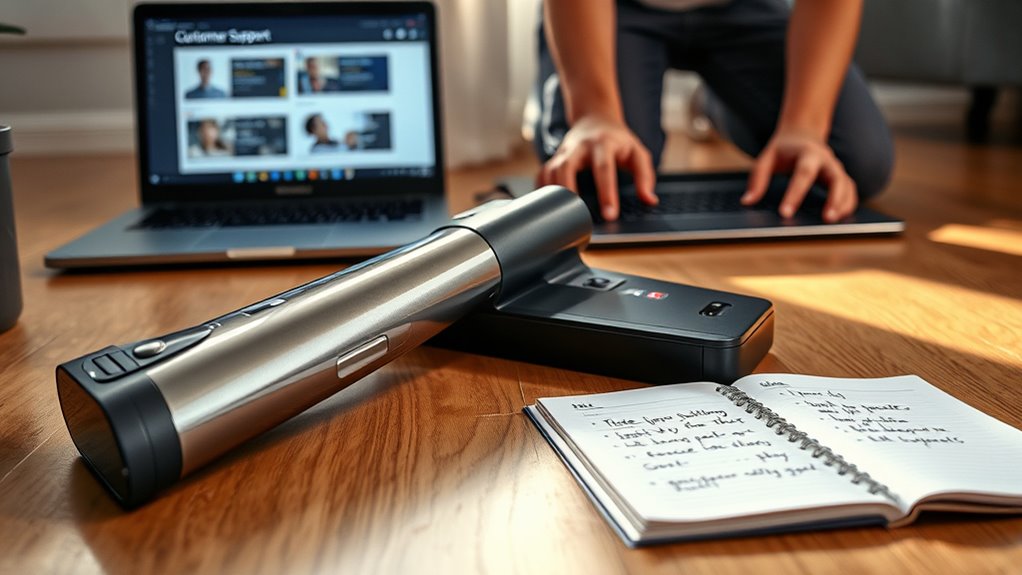
Experiencing persistent noise from your vacuum can be frustrating, and knowing where to turn for help makes all the difference.
Many customers have found that support resources can be invaluable for troubleshooting issues.
- Quick resolutions from knowledgeable support staff
- Expert advice on checking for blockages and damage
- Access to articles and guides for common problems
Positive customer experiences highlight the professionalism and responsiveness of support teams, often leading to swift solutions.
With experts holding qualifications in appliance repair, you can trust their guidance.
Don’t hesitate to explore these resources; they provide extensive help that can turn a frustrating situation into a manageable one, ensuring your vacuum operates quietly and efficiently once again.
Frequently Asked Questions
Why Is My Vacuum Making Weird Noises?
If your vacuum’s making weird noises, it could be a sign of a few issues.
You might’ve a clogged filter or a blockage in the tube, which can restrict airflow.
Check for any loose or damaged parts, like the fan or brush bearings, as they can create excessive noise.
It’s crucial to inspect these components regularly to keep your vacuum running smoothly and quietly.
Don’t ignore those sounds—they often signal a problem that needs fixing!
How Do You Know if Your Vacuum Motor Is Burnt Out?
You can tell if your vacuum motor’s burnt out by noticing a few key signs.
If you smell burning or see smoke, that’s a big red flag.
Listen for loud grinding or rattling noises when it runs, which often means internal damage.
Also, if the suction drops considerably despite clean filters, it’s likely an issue.
Finally, if the motor won’t start or runs intermittently, it’s time to check for electrical problems.
How to Fix a Noisy Vacuum Cleaner?
Ever wondered why your vacuum’s so noisy?
To fix it, start by checking and cleaning the filters; clogged ones can really ramp up noise.
Next, inspect the vacuum tube for blockages and clear any debris.
Don’t forget to examine the fan near the motor for any damage.
Ultimately, keep an eye on the brush bearings—worn-out ones can create extra noise.
Regular maintenance can keep your vacuum running smoothly and quietly!
Why Is My Vacuum Making a Rattling Noise?
If your vacuum’s making a rattling noise, it could be due to debris stuck in the brush roll or vacuum bag.
Check the wheels for foreign objects and make certain all components are securely fastened.
Loose screws or damaged parts might also cause the noise.
Finally, inspect for clogs or wear in the motor or fan assembly.
Regular maintenance can help prevent these issues and keep your vacuum running smoothly.
Conclusion
In the symphony of household chores, your vacuum should be the gentle hum of a well-tuned instrument, not a discordant clash. By understanding the common causes of noise and taking proactive steps, you can tune your appliance to perform harmoniously. Should the cacophony persist, don’t hesitate to seek professional guidance. Remember, even the finest orchestras require a skilled conductor to flourish. With patience and care, you’ll restore peace to your cleaning routine and enjoy a quieter home.
